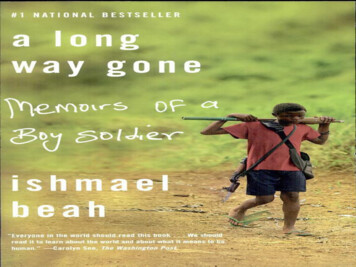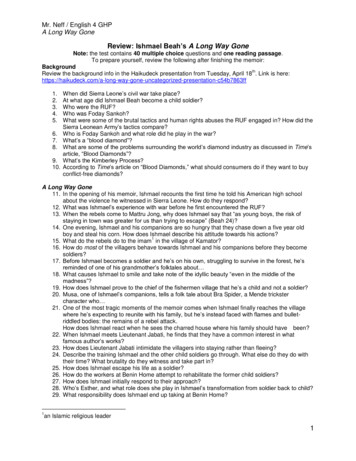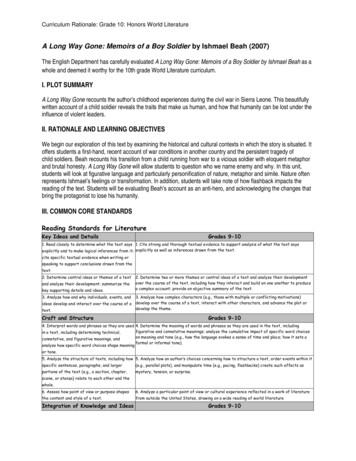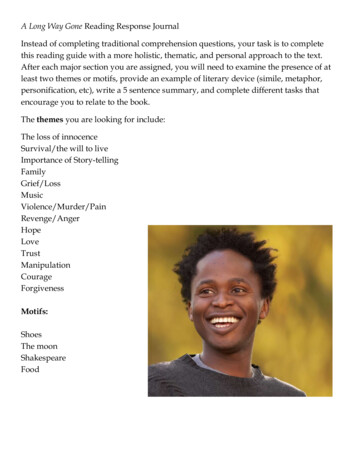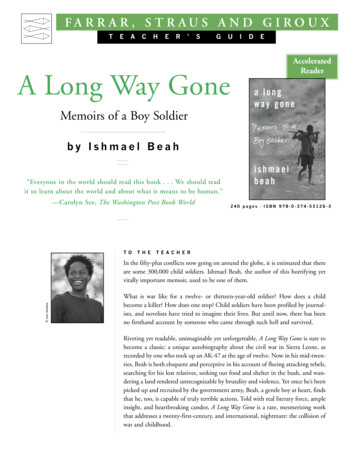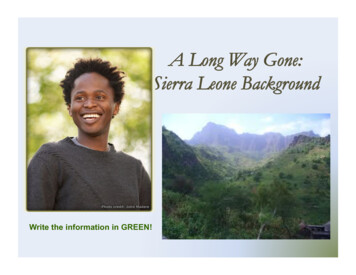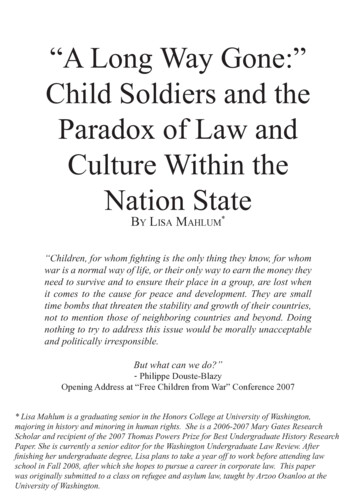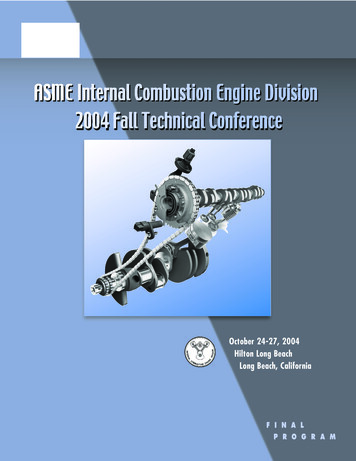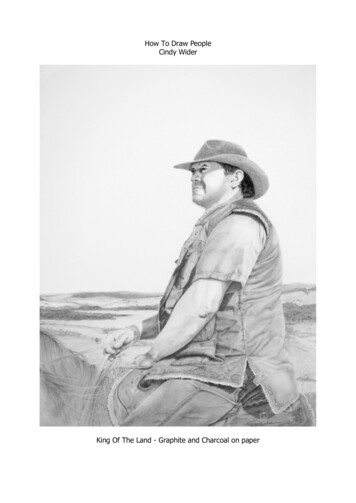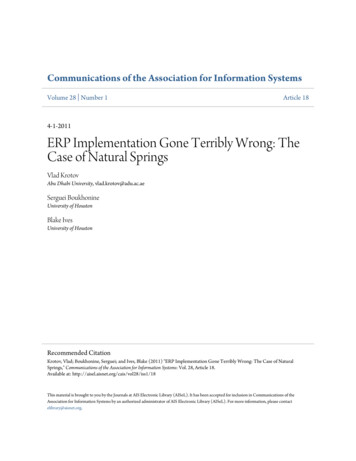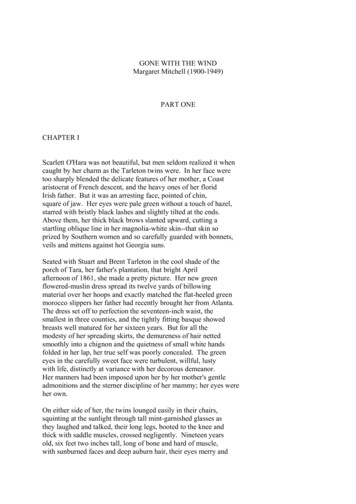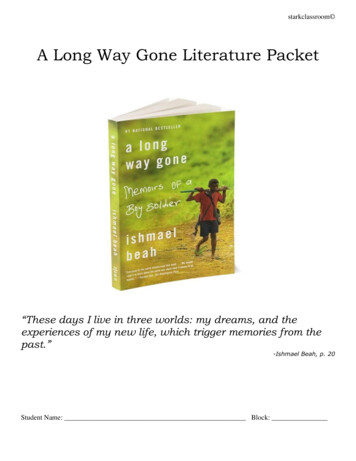
Transcription
starkclassroom A Long Way Gone Literature Packet“These days I live in three worlds: my dreams, and theexperiences of my new life, which trigger memories from thepast.”-Ishmael Beah, p. 20Student Name: Block:
starkclassroom IntroductionFrom: Reading Group GoldAn estimated 300,000 child soldiers now fight in the more than fifty violent conflicts raging around the globe.Far removed from the world of pundits and journalists, policymakers and diplomats, a thirteen-year-old boynamed Ishmael Beah became one of these young warriors in Sierra Leone. Now in his mid-twenties, hecourageously tells of the horrific road that led him to wield an AK-47 and, fueled by trauma and drugs, committerrible acts. A Long Way Gone brings a rare voice of frontline realism to a widely publicized (and widelymisunderstood) human-rights crisis.In poignantly clear and dauntless storytelling, Ishmael describes how he fled brutal rebel soldiers, travelingmiles from home on foot and gradually being reduced to a life of raw survival instincts. Yet, unlike so many ofhis peers, Ishmael lived to reclaim his true self, emerging from Sierra Leone as the gentle, hopeful young manhe was at heart. His memoir is at once crucial testimony for understanding the tragedy of contemporary warzones, and a testament to the power of peacemakers.A Long Way Gone is a plea for understanding of a political and social climate which allows innocent children tobecome killers. More than that, it is an attempt to move readers to action, essentially asking them to find waysto end the abhorrent tragedies occurring not just on the African continent, but all over the world.Overview of the Sierra Leone Civil WarThe Sierra Leone civil war began in 1991 with the attacks of the Revolutionary United Front (RUF), led byformer army corporal Foday Sankoh, on government military and civilian targets. While allegedly begun as aresponse to the corrupt government of President Joseph Saidu Momoh, the RUF quickly turned to acts of terrorand violence with little regard to its ostensible political agenda. The RUF captured towns on the Liberianborder, killing and torturing numerous citizens. The President is ousted in 1992, setting up a cycle of militarycoups for the next five years. In 1996, after the first multi-party election in nearly thirty years, Ahmad TejanKabbah is elected President. He signs a peace accord with the RUF. Kabbah is ousted by yet another militarycoup, led by Johnny Paul Koroma and the Armed Forces Revolutionary Council (AFRC) - a force consisting ofboth army and RUF soldiers who previously fought against one another.Atrocities were committed on both sides of the conflict, which resulted in over 50,000 killed and one millionpeople displaced. Despite the level of violence, national attention was not drawn to Sierra Leone until 1999,when the United Nations intervened to establish the Lome Peace Accord. This treaty made the RUF commandervice-president of the country with control over Sierra Leone’s valuable diamond mines.Despite the accord, RUF forces continued their attacks and seemingly random acts of violence againstgovernment and civilian targets. The UN sought disarmament, but response on both sides was slow. Eventually,Great Britain intervened, sending in troops to capture RUF forces and restore full power to then-presidentKabbah. In 2000, RUF leader Sankoh was captured. Over the next year, UN forces complete disarmament andthe war is declared over in 2002. Newly re-elected President Kabbah declared the conflict ended in 2002.
starkclassroom Biographies of Individuals Included in the Novel(Copied from: ide/character-list/)Ishmael BeahThe narrator and author of the book. When Beah is a teenager, he spends a year wandering Sierra Leoneon the run from the civil war that claims his family. His childhood ended, Beah resorts to survivalist tacticsto stay alive; he steals when he needs to, roams in packs of boys his own age who have been orphaned,and he spends long stretches of time alone in the forest. At 13, he is forced to become a soldier for thegovernment's army and is ordered to kill rebels - many of whom are boys his own age. Beah witnessesand perpetrates numerous atrocities before he is rescued and rehabilitated by UNICEF. He speaks atseveral international conferences on children and war, including one at the United Nations. He currentlylives in New York.JuniorIshmael Beah's elder brother. Junior is protective of Beah, as he has been for all of the younger boy's life.It is to Junior that Beah looks for reassurance during their trials. Beah is separated from Junior during arebel attack on Kamator and never sees his older brother again.MusaMusa is a Mende boy who was in Mattru Jong when the rebels attacked. Musa and his father wereseparated from his mother during the attack. Musa's father ordered him to stay where he was until hecould return with his wife; as soon as Musa's father returned to the village, the attack grew in intensityand Musa was forced to run. He is among the six boys Beah finds in the forest after his month of isolation.Musa is the storyteller of the group.AlhajiAlhaji is a Temne boy who was at the river fetching water when the rebels attacked his village. Hereturned home to find his family, but all he was able to find was an empty house. Alhaji is among the sixboys Beah encounters after his month of isolation in the forest. He remains a close friend of Beah's evenas they are rescued together by UNICEF.KaneiKanei is a Mende boy who escaped the rebels' attack on his village with his parents, but lost his twosisters and three brothers in the chaos. He and his parents escape in a boat, but the boat capsized whenrebels threw the passengers into panic by shooting at them. Kanei swam to the other side of the river andwitnessed many people drowning in the river while the rebels laughed at their suffering. He follows theother survivors in the hope of locating his parents, whom others tell him have passed through the area.Kanei is among the six boys Beah encounters after his month of isolation in the forest.JumahJumah is a Mende boy whose house was destroyed by an RPG during the RUF attack on his village. Heruns toward the wharf to find his parents, but cannot locate them. Along with Moriba, Jumah flees into theforest to find their hiding families, but cannot discover their whereabouts. Jumah is among the six boysBeah encounters after his month of isolation in the forest.MoribaMoriba is a Mende boy whose house was destroyed by an RPG during the RUF attack on his village. Heruns toward the wharf to find his parents, but cannot locate them. Along with Jumah, Moriba flees into theforest to find their hiding families, but cannot discover their whereabouts. Moriba is among the six boysBeah encounters after his month of isolation in the forest.GibrillaGibrilla is one of the boys who accompanies Beah and Junior after they are forced to leave Mattru Jong.TalloiTalloi is with Junior and Beah when they initially go to Mattru Jong to practice with their dance group.After the rebel attacks, Talloi is among the group of six boys that travel together until the siege ofKamator.
starkclassroom SaiduSaidu is a Temne boy whose family was unable to leave the village during the rebel attack. He and hisfamily hide under their beds during the night of the attack. The next morning, rebels broke into the houseand rape his three sisters. Because he is in the attic retrieving rice for his family at the time, Saidu is safebut is forced to hear the sounds of their suffering as the rebels assault them. The rebels then forcedSaidu's parents to pack up and carry their belongings for the rebels depart, taking the sisters with them.Saidu is among the six boys whom Beah encounters following his month of isolation in the forest.Later, Saidu "faints" when three white-clothed figures--whom the boys believe to be ghosts--pass them inthe forest one night. Saidu is catatonic for a long time, but recovers. Unfortunately, he once again slipsinto this coma when the boys find a welcoming village. That night, Saidu dies.KalokoKaloko travels among the group of six boys from Mattru Jong through Kamator.KhalilouBeah, Junior, Talloi, Kaloko, and Gibrilla stay with Khalilou's family in Mattru Jong after the attack on theirvillage. Khalilou's family leaves them to watch the house when the rebels are rumored to have targetedMattru Jong. These six boys stay together until Kamator is raided.MohamedBeah's best friend before the war. He is unable to travel with his friends to Mattru Jong for the dancegroup practice, so he is present when the rebels attack Mogbwemo. Amazingly, Beah is reunited withMohamed years later at the UNICEF rehabilitation camp.Lieutenant JabatiJabati is Ishmael Beah's commanding officer during his service in the Sierra Leone military. Jabati isknown for reading and quoting Shakespeare, particularly Julius Caesar; he is also known as an orator whowould lecture and exhort his troops for hours in preparation for future combat. Jabati has a flair for thedramatic, once displaying the bodies of a man and his son to the villagers as a deterrent to their fleeinginto the forest where the rebels are hidden.Beah comes to trust Jabati as he does no other adult, primarily due to his position of authority and thenecessity of such trust to survival. Jabati seemingly betrays Beah by selecting him to be among thechildren taken by UNICEF to be offered a second chance at normal lives.Corporal GadafiGadafi is the officer in charge of training the boy soldiers under Lieutenant Jabati. He is tough on the boys,but seems motivated to harshness by a desire to see them survive the armed conflict. He does nothesitate to push the boys beyond their sense of humanity, particularly in the instance where he holds acompetition to see which boy can kill a prisoner by cutting his throat the most effectively and quickly.Uncle TommyA relative of Beah's father, Tommy is mentioned almost in passing by Beah when the UNICEF workerLeslie tells him he will be placed in a foster home. Tommy is located and immediately comes to begindeveloping a relationship with Beah. Although Beah is skeptical of any possible connection at first,Tommy's patience and good humor win Beah over to accepting him as his benefactor.Uncle Tommy and his wife have no children of their own, but have adopted several children from familymembers unable to care for their own. Beah is the next to last child taken in (Beah's childhood friendMohamed is the last) by the family. Uncle Tommy provides a safe environment for Beah to recoup fromhis trauma; this safety is shattered with a resurgence of violence in Freetown and the eventual death bydisease of Uncle Tommy.EstherEsther is the nurse at the UNICEF compound where Beah convalesces following his escape from the life asa child soldier. She attempts to win Beah's trust by patiently showing an interest in him without pushinghim. She even uses reverse psychology by challenging Beah to win her trust before she will talk with himat length. She learns of Beah's interests through the school questionnaires and uses this knowledge tobreak down Beah's emotional barriers. She considers Beah a brother and consoles him in his most dismalemotional troubles.
starkclassroom Laura SimmsLaura Simms is a facilitator for the United Nations First Children's Parliament; her workshop is intended tohelp the children learn more effective ways of communicating their harrowing experiences to theiraudience. Beah connects with her immediately because she is a storyteller and he comes from a culturestrong in storytelling roots. Laura eventually adopts Beah as her son when he escapes the resurgence ofviolence in Sierra Leone.FatherBefore the war, Beah has a complicated relationship with his father. He is a carefree man, invested in thefutures of his sons. However, a relationship with a new woman has soured the relationship with hisIshmael and Junior. Still, Beah has fond memories of his father that he comforts him during his ordeal. Heis presumed dead.MotherBeah's mother loves her sons despite the divorce that has torn their family apart. Beah recalls visits withhis mother and brother Ibrahim, trips to the market, and her teaching him how to cook during his ordeal.She is presumed dead.Mamie KpanaIshmael's grandmother. Mamie Kpana is a calm presence in Beah's pre-war life.IbrahimBeah's younger brother. He lives with their mother following their parents' divorce. Ibrahim attends schoolunlike his brothers, as his mother is solely devoted to his upbringing. After the attack on Mogbwemo,Beah never sees Ibrahim again.ShekuSheku is a tent-mate of Beah's at the army-occupied village. They become soldiers together.JosiahJosiah is a tent-mate of Beah's when he becomes a soldier. Josiah dies of a broken back during one oftheir first raids.GasemuGasemu recognizes Beah from Mattru Jong. When they arrive to the outskirts of the village where it isrumored his parents have taken refuge in, Gasemu greets the boys. Instead of letting Beah run on to thevillage, he makes them help him carry bananas. While they are walking on to the village, rebels attackand all are killed. Beah blames Gasemu for keeping him from his family, though he comes to realize that itis not his fault and he is alive, once again, because of a twist of fate.Mr. KamaraThe head of Benin Home who encourages Beah to speak publicly about his experiences.LeslieA kind worker at Benin Home.Aunt SallayUncle Tommy's wife. She treats Beah like her own son.AllieUncle Tommy's son. Beah and Allie share a room after Beah leaves Benin Home. Allie takes Beah to adance and gives him city clothes as a way to introduce him to his new, post-war life.Dr. TambaThe sponsor from Sierra Leone who accompanies Beah and Bah to New York City.BahA Sierra Leonean boy who travels with Beah to represent their country at the UN.
starkclassroom Major ThemesAs you read through the novel A Long Way Gone, be sure to log examples of each of thefollowing key themes. You will need to cite specific examples of these themes at theconclusion of this novel as part of the essay portion for the Unit Exam.SurvivalMemoryLoss of InnocenceNatureLife and HopeFamilyThe Damages of War
starkclassroom Daily Writing Prompts:Daily Writing ResponsesDirections: Students are to first read the assigned chapters for the book A Long Way Gone. Then students are to writereflective essays for each writing response listed below. Each chapter’s writing responses are due at the conclusion ofeach chapter. Writing responses may be a minimum of one paragraph (5 sentences). However to earn full credit, theinstructor will be using the following RUBRIC:F(0 – 59%)D(60 – 69%)C(70 – 79%)B(80 – 89%)A(90 – 100%) Length of responseis less than 2sentences Writing is unclear Length of responseis at least 2sentences Writing is unclearand not fluent Length of response isat least 3 sentences Writing is on topic Length of response isat least 4 sentences Writing is clear,concise, and on topic Length of response isat least 5 sentences Writing is fluent,clear, concise, and ontopic Spelling is mostlyaccurateVocabulary is usedaccordingly Spelling is accurateVocabulary is usedaccordingly and withpurposeWriting reflectsindependent thought Writing reflects deepunderstanding of textreading andindependent thoughtResponse is turned inon time Spelling isinaccurateVocabulary is notused accordingly Spelling isinaccurateVocabulary is usedpoorly Writing reflects noknowledge ofchapter text reading Writing reflectsminimumknowledge of textreading Spelling is moreaccurate – does notdistract fromunderstandingVocabulary is usedaccordinglyWriting reflectsbasic knowledge oftext reading CHAPTER 11.Why does the author use the word “touched” when referring to the war, as opposed to using such wordsas “affected” or “involved”?
2.3.starkclassroom What benefits were there for the militant rebels to attack mining villages first? What type of impact didthese attacks have on Sierra Leone’s natural resources?What psychological impacts can be attributed to a person not being able to differentiate between“Dreams and Reality”? Why might a human brain choose to blur the two together?CHAPTER 24.What would make you scared to sleep?
starkclassroom CHAPTER 35.Why did the rebels spare the Catholic Bishop? What does this action tell about the mentality of the rebelsoldiers?6.What are some possible motives for the rebels giving up their chase for Junior, Talloi, Ishmael, Gibrilla,Okaloko and Khalilou?
starkclassroom Chapter 47.Why do you think the young boy from page 28 refused to “drop the bag and hurry”?Chapter 58.What psychological effects were created when the rebels shot their rifles near the old man’s head? Ispsychological warfare just as effective as physical warfare?9.Describe a time in your life when you found yourself in a “separate line” from a family member orfriend. Think about the separate lines that Ishmael and his brother Junior were placed in. What thoughtswould you be having if you were in the position of Ishmael? What about if you were Junior?
starkclassroom Chapter 610.“This was one of the consequences of the civil war. People stopped trusting each other, and everystranger became an enemy”. Ishmael Beah wrote this quote in chapter 6 of his autobiography A LongWay Gone. Describe the possible effects that this mentality can hold on a civilization.11.Explain the way Ishmael felt towards his neighbors who felt that Ishmael and his brother “ aren’tgoing to have any good complete training”.
starkclassroom Chapter 712.Why is silence scary? Elaborate on Ishmael’s thoughts that he was “frustrated with living in fear”.13.Personal Connection: Describe a time in your life when you didn’t know where you were going? Orcouldn’t remember where you had come from?
starkclassroom Chapter 814.Explain the quote “If you are alive, there is hope for a better day and something good to happen. If thereis nothing good left in the destiny of a person, he or she will die”. Thinking about this moment inIshmael’s life from chapter eight, where do you think Ishmael stands in accordance to this quote?15.Describe the transformation of Ishmael’s personality from the beginning of his autobiography to his selfreflection in chapter 8.
starkclassroom Chapter 916.Make an analogy: Compare the strength of the waves to the “waves” in Ishmael’s life.17.Complete the story: Think about the fisherman who walked into the fishing hut and found Ishmael andhis six friends there with the skin on the bottom of their feet hanging off. According to Ishmael on page61, the fisherman “shook his head and left”. What do you think is going to happen next? Is yourprediction what you think is actually going to happen in the book, or what you want to happen in thestory?
starkclassroom Chapter 1018.Explain the quote “Even though I am still alive, I fell like each time I accept death, part of me dies”.19.Describe in detail at least 3 acts of kindness presented in chapter 10.
starkclassroom Chapter 1120.Why do you think Ishmael refused the “jug of water” from Ngor Gasemu?21.Make an Inference: How do you think Gasemu was feeling as he sat near “a mango tree” on page 96?Why didn’t he react to Ishmael in anger or hostility?22.What do you think is more sad in accordance to the study of basic humanity, the fact that the rebels“boasted about what they had done that day”, or the fact that the actions were committed by youths?Explain your position in detail.
starkclassroom Chapter 1223.Make a Prediction – Think about the last paragraph from chapter 11. Based on those events, whatevents do you think are in store for Ishmael and the other five boys in chapter 12?24.Why do you think Lieutenant Jabati was fascinated with Julius Caesar?25.Ishmael states that “They have lost everything that makes them human” (p. 108). What does he mean bythis statement? What implications are there now that he has spoken these words aloud.
starkclassroom Chapter 1326.Make a justification: Is there validity to the statement (in context), “It is better to carry moreammunition than food and water.”27.What does Josiah’s last words say about the type of soldiers fighting and dying in this war?28.Construct a “diagram” showing the boys Ishmael has traveled with since he left Mogbwemo andwhat/where they are at the close of chapter 13.
starkclassroom Chapter 1429.Explore the ramifications of exposing children to violent images such as “Rambo” or “Commando”?30.Describe any transitions you believe Ishmael has gone through since he was first separated from hisbrother in Mattru jong:31.Would the Ishmael of Chapters 13 & 14 be recognizable to the Ishmael of chapters 1,3&4? Investigatehow Ishmael has evolved as a man.
starkclassroom For each of the remaining chapters of this book, create yourown writing prompt and then either complete it yourselfor have a peer write a response.Chapter 1532.Chapter 1633.
starkclassroom Chapter 1734.Chapter 1835.
starkclassroom Chapter 1936.Chapter 2037.
starkclassroom Chapter 2138. Develop your thoughts on Ishmael’s response to the riddle asked by Pa Sesay.
starkclassroom Directions: Cut out the template below.Select 4 people from the novel you believehad the most impact on Ishmael’s life.In each Triangle, construct a mini-collagedisplaying biographical information abouteach of the chosen people. Be sure to labeleach triangle with the person’s name.
starkclassroom END OF NOVEL ESSAY QUESTIONSAfter completing the novel A Long Way Gone, Students must select 1 of the followingessay questions to complete. In order to fully complete the following essay questions,students must fully develop their understanding/interpretation of the question bysubmitting ALL of the following items:A. 750 word student written response ( 3 typed pages)- If student selects to type their essay response, essay should follow properformat. ie: 12 point Times New Roman font, double spaced, 1”margins.B. Visual presentation capturing the overarching theme of the essay questionESSAY I AM CHOSING TO COMPLETE:Essay Choices:1. How familiar were you with the civil wars of Sierra Leone prior to reading A Long Way Gone? Howhas Ishmael’s story changed your perception of this history, and of current wars in general?2. Chapter seven begins with the story of the imam’s death, followed by Ishmael’s recollections of hisfather and an elder blessing their home when they first moved to Mogbwemo. How do the conceptsof faith and hope shift throughout this memoir? What sustains Ishmael emotionally and spiritually?3. Chapter eight closes with the image of villagers running fearfully from Ishmael and his friends,believing that the seven boys are rebels. How do they overcome these negative assumptions incommunities that have begun to associate the boys’ appearance with evil? What lessons couldworld leaders learn from them about overcoming distrust, and the importance of judging othersindividually rather than as stereotypes?4. What did Ishmael’s parents teach him about being a man? How did he define manhood once hebegan his long walk west? What general life lessons were his parents able to teach him thatsustained him during his brutal passage from boyhood, and that he carries with him to this day?5. Discuss the role of American hip-hop culture in creating a “soundtrack” for Ishmael’s life. Why arerappers so appealing to him?6. The boys’ discovery of the Atlantic Ocean and their encounter with a cheerful fisherman who healsand feeds them is followed by the tragedy of Saidu’s death after a bird falls ominously from the sky.Discuss Ishmael’s relationship with the natural world. In what way is he guided by the constancy ofthe earth and sky?7. When Ishmael arrives at the fortified village of Yele in chapter twelve, what do you discover aboutthe way he began his military career? Was his service, and that of his equally young friends,necessary? What made his conscription different from that of drafted American soldiers serving inprevious wars?8. Ishmael tells us that some of the boys who had been rehabilitated with him later became soldiersagain. What factors ensured that he could remain a civilian?
starkclassroom 9. Storytelling is a powerful force in Ishmael’s life, even providing a connection to his future mother,Laura Simms. What traits make Ishmael a memorable and unique storyteller? How does hisperspective compare to the perspectives of filmmakers, reporters, or other authors who haverecently tried to portray Africa’s civil wars?10. Ishmael describes his use of Krio and many tribal languages to communicate, as well as hisability to quote Shakespeare’s Elizabethan English. What communities and empires arerepresented in his many speech styles? In which “villages,” from the relatively new UN to thecenturies-old Mende and Temne settlements, does the greatest wisdom lie?11. How does Ishmael’s concept of family change throughout the memoir, from his early life in MattruJong, to the uncle with whom he is reunited, to his American family with Laura?12. It takes many weeks before Ishmael feels comfortable with the relief workers’ refrain that theseevents are not his fault. What destructive beliefs had he become addicted to? What states ofdeprivation and euphoria had his body become addicted to?13. What universal truths does Ishmael teach us about surviving loss and hunger, and overcomingisolation?14. Ishmael’s dramatic escape during the later waves of revolution concludes with the riddle of themonkey. Is his dream of obliterating the monkey—and its violent endgames—closer to beingfulfilled in these early years of the twenty-first century? What would it take for all of humanity toadopt Ishmael’s rejection of vengeance?15. Ishmael gives credit to relief workers such as Esther, in conjunction with organizations such asUNICEF, for rescuing him. He has dedicated his life to their cause, studying political science andspeaking before a broad variety of groups, ranging from the Council on Foreign Relations to theCenter for Emerging Threats and Opportunities at the Marine Corps Warfighting Laboratory. Whatsteps has he inspired you to take to help end the use of child soldiers? How can each of us joinIshmael’s cause?16. After reading the chronology of Sierra Leone’s history, what reasons can you propose for thecoups in Ishmael’s homeland? Did the arrival of Portuguese slave traders, or the later colonizationby the British, contribute to Sierra Leone’s twentieth century woes? What did you discover aboutthe motivations of the army soldiers versus those of the rebels? In your opinion, what made theleaders of the RUF so ruthless for so long?Be sure to access the AR test forA Long Way Gone You could earn 13 points!
A Long Way Gone is a plea for understanding of a political and social climate which allows innocent children to become killers. More than that, it is an attempt to move readers to action, essentially asking them to find ways to end the abhorrent tragedies occurring n
